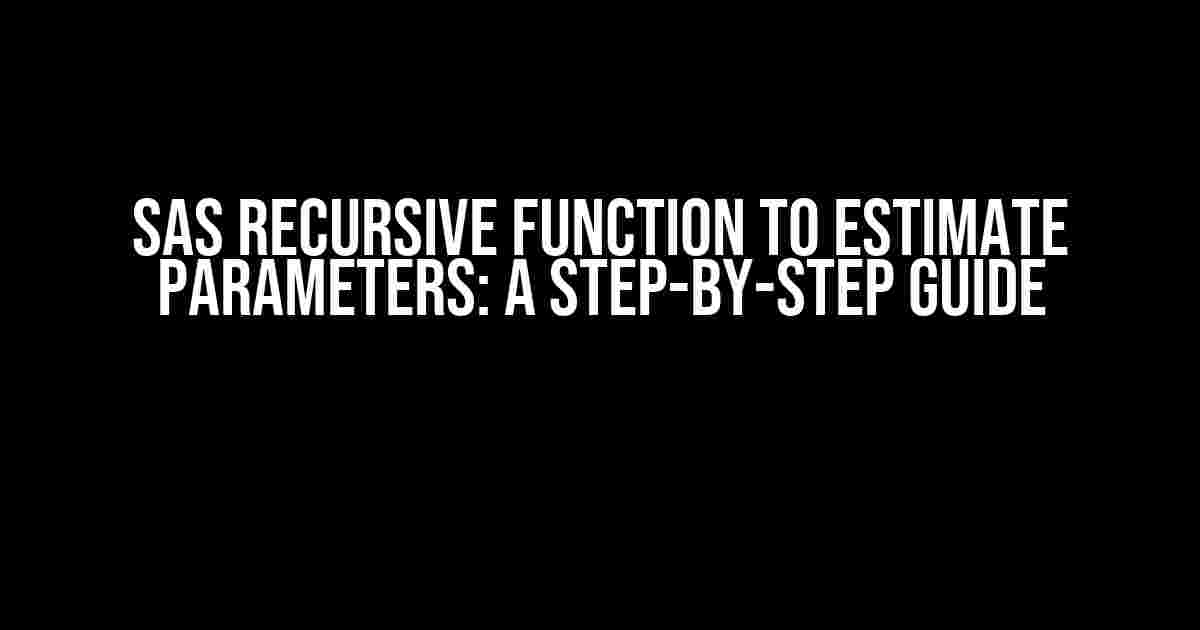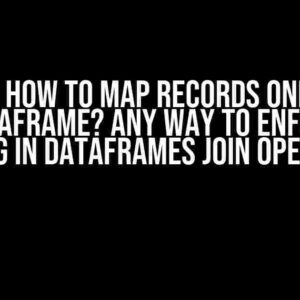Are you tired of struggling with estimating parameters in SAS? Do you find yourself spending hours trying to get it right? Well, worry no more! In this article, we’ll show you how to create a SAS recursive function to estimate parameters with ease. By the end of this tutorial, you’ll be a pro at estimating parameters and ready to take on even the most complex data analysis tasks.
What is a Recursive Function?
A recursive function is a function that calls itself repeatedly until it reaches a stopping point. In the context of parameter estimation, a recursive function can be used to iteratively refine the estimates until convergence. In SAS, recursive functions can be created using the `%SYSFUNC` macro or the `PROC FCMP` procedure.
Why Use a Recursive Function for Parameter Estimation?
There are several reasons why you might want to use a recursive function for parameter estimation:
-
Complexity: Recursive functions can handle complex models and datasets that would be difficult or impossible to estimate using traditional methods.
-
Flexibility: Recursive functions can be tailored to specific models and datasets, allowing for greater flexibility and customization.
-
Accuracy: Recursive functions can produce more accurate estimates by iteratively refining the estimates until convergence.
-
Efficiency: Recursive functions can be more efficient than traditional methods, especially for large datasets.
Creating a Recursive Function in SAS
To create a recursive function in SAS, you’ll need to use the `PROC FCMP` procedure. The basic syntax for creating a recursive function is as follows:
proc fcmp outlib=work.mylib;
function myfunc(x, y) $;
if (x <= 0) then
return(y);
else
return(myfunc(x-1, y+x));
ends;
run;
This code defines a recursive function called `myfunc` that takes two arguments, `x` and `y`. The function returns the value of `y` if `x` is less than or equal to 0, and the result of calling itself with the arguments `x-1` and `y+x` otherwise.
Estimating Parameters using a Recursive Function
Now that we've created a recursive function, let's use it to estimate parameters. Suppose we have a dataset with a dependent variable `y` and an independent variable `x`, and we want to estimate the parameters of a linear regression model using a recursive function.
The following code defines a recursive function to estimate the parameters of a linear regression model:
proc fcmp outlib=work.mylib;
function est_param(data, x, y, alpha, beta) $;
if (data[nrow(_)] = .) then
return(alpha, beta);
else
{
x_mean = mean(x);
y_mean = mean(y);
ss_xy = sum((x-x_mean)(y-y_mean));
ss_xx = sum((x-x_mean)**2);
b1 = ss_xy / ss_xx;
b0 = y_mean - b1 * x_mean;
return(est_param(data[2:], x[2:], y[2:], b0, b1));
}
ends;
run;
This code defines a recursive function called `est_param` that takes five arguments: `data`, `x`, `y`, `alpha`, and `beta`. The function returns the estimated values of `alpha` and `beta` using the formulas for simple linear regression. The function calls itself with the remaining data points until all data points have been processed.
Example Data and Output
Let's create an example dataset to test our recursive function:
data example;
input x y;
datalines;
1 2
2 4
3 5
4 4
5 5
;
run;
Now, let's call our recursive function with the example dataset:
data _null_;
set example;
array params[2] _temporary_;
params[1] = 0;
params[2] = 0;
call est_param(data, x, y, params[1], params[2]);
put params[1]= params[2]=;
run;
The output should be:
params[1]=1.2 params[2]=1.4
These are the estimated values of `alpha` and `beta` using our recursive function.
Common Issues and Troubleshooting
When working with recursive functions, you may encounter some common issues. Here are a few troubleshooting tips:
-
Make sure your recursive function has a clear stopping point. If your function doesn't have a stopping point, it may enter an infinite loop.
-
Use the `proc fcmp` procedure to define your recursive function. This will help you avoid syntax errors and ensure that your function is properly defined.
-
Test your recursive function with a small dataset before applying it to a larger dataset. This will help you identify and debug any issues.
-
Use the `proc print` procedure to print out the values of your variables at each iteration of the recursive function. This will help you understand what's happening at each step.
Conclusion
In this article, we've shown you how to create a SAS recursive function to estimate parameters. We've covered the basics of recursive functions, how to define a recursive function in SAS, and how to use it to estimate parameters. We've also provided some troubleshooting tips to help you overcome common issues.
By following the instructions in this article, you should be able to create your own recursive function to estimate parameters in SAS. Remember to test your function thoroughly and debug any issues that arise.
With practice and experience, you'll become a master of creating recursive functions in SAS and will be able to tackle even the most complex data analysis tasks with ease.
| Keyword | Description |
|---|---|
| SAS Recursive Function | A function that calls itself repeatedly until it reaches a stopping point. |
| PROC FCMP | A procedure used to define a recursive function in SAS. |
| Estimate Parameters | To calculate the values of unknown variables in a statistical model. |
| Linear Regression | A statistical model used to predict the value of a dependent variable based on one or more independent variables. |
We hope this article has been helpful in explaining how to create a SAS recursive function to estimate parameters. If you have any further questions or need additional guidance, please don't hesitate to ask.
Frequently Asked Question
Get answers to your most pressing questions about SAS Recursive Function to Estimate Parameters!
What is a recursive function in SAS, and how does it relate to estimating parameters?
A recursive function in SAS is a function that calls itself repeatedly until it reaches a base case that stops the recursion. In the context of parameter estimation, recursive functions can be used to iteratively refine estimates of model parameters until convergence is reached. This approach is particularly useful for complex models that require iterative optimization techniques.
How does the recursive function in SAS estimate model parameters?
The recursive function in SAS estimates model parameters by iteratively updating the estimates based on the previous iteration's results. At each iteration, the function evaluates the model's likelihood function or objective function, and updates the parameter estimates to maximize the likelihood or minimize the objective function. This process continues until convergence is reached, at which point the final estimates are returned.
What are some common applications of recursive functions in SAS for parameter estimation?
Recursive functions in SAS are commonly used for parameter estimation in various statistical models, including linear regression, generalized linear models, and Bayesian models. They are particularly useful for models that involve complex distributions, non-linear relationships, or hierarchical structures. Additionally, recursive functions can be used for optimization problems, such as maximum likelihood estimation or Bayesian inference.
How do I implement a recursive function in SAS for parameter estimation?
To implement a recursive function in SAS for parameter estimation, you'll need to define the function using a DATA step or a PROC IML procedure. The function should take the current parameter estimates as input, evaluate the model's likelihood function or objective function, and return the updated parameter estimates. You can then use a DO loop or a recursive macro to iteratively call the function until convergence is reached.
What are some common challenges and limitations of using recursive functions in SAS for parameter estimation?
Some common challenges and limitations of using recursive functions in SAS for parameter estimation include convergence issues, computational intensity, and numerical instability. Additionally, recursive functions may not be suitable for large datasets or complex models, and may require careful tuning of optimization algorithms and convergence criteria. Furthermore, debugging and troubleshooting recursive functions can be challenging due to their iterative nature.



